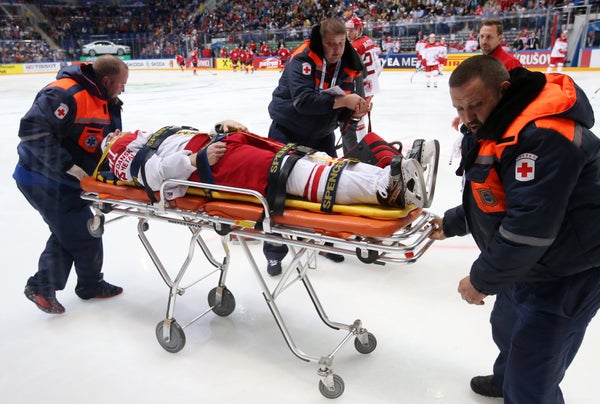In the world of recreational and professional sports, many athletes—particularly in contact sports—suffer concussions. These mild traumatic brain injuries cause headaches, memory problems and confusion, but usually resolve on their own with rest.
Some players, however, especially after repeated concussions, continue to experience symptoms for many months—a phenomenon termed post-concussion syndrome. A few of these players will eventually develop chronic traumatic encephalopathy (CTE), a progressive neurodegenerative disease that causes dementia symptoms similar to Alzheimer’s disease. CTE can lead to personality changes, movement problems and, sometimes, mortality.
CTE is diagnosed after death because it requires postmortem examination of a player’s brain. Post-concussion syndrome, in contrast, is diagnosed based on patient symptoms. To date, doctors do not have any objective tests to determine syndrome severity or relate it to the risk of developing CTE.
On supporting science journalism
If you're enjoying this article, consider supporting our award-winning journalism by subscribing. By purchasing a subscription you are helping to ensure the future of impactful stories about the discoveries and ideas shaping our world today.
Now, a group of researchers from Sweden and the U.K. say they have developed such a test, reporting their findings last week in JAMA Neurology. The test measures biomarkers in the cerebrospinal fluid—the colorless liquid that supports and suspends the brain and spinal cord—that appear to provide a measure of concussion severity and CTE risk.
The researchers collected cerebrospinal fluid via spinal taps from 16 professional Swedish ice hockey players and a similar number of healthy individuals. The hockey players had all experienced post-concussion syndrome, causing nine of them to retire from the game.
The hockey players had elevated levels of neurofilament light protein (NFL), a marker of damage to axons, the cables neurons use to communicate, the researchers found. Levels of this protein were higher in players whose symptoms persisted longer and were more severe as well as in those who had more concussions. A toxic version of another protein, tau, which normally helps these cables function, was higher in players who had experienced more concussions. Finally, these highly concussed players also had signs of early deposition of amyloid beta, an irregular protein that builds up in the brains of about half of patients with CTE, causing cell death. The toxic version of tau and amyloid beta are also implicated in Alzheimer’s disease. “This is the first study on biomarkers for sports-related post-concussion syndrome,” says Kaj Blennow, a clinical neurochemist at the University of Gothenburg’s Sahlgrenska University Hospital and senior author of the study. It establishes a method to stratify players by their injury severity and introduces a possible biological link between post-concussion syndrome and CTE, he adds.
When an athlete experiences a concussion, different protocols are followed based on the sports organization. Most commonly, players are evaluated on the sideline using a symptoms checklist and may be allowed to reenter the game. If the symptoms are severe, a player must leave the field. Should the symptoms persist for more than three months (post-concussion syndrome), a player and his or her team must discuss when—or whether—he or she will return to the sport. A test for specific proteins could add clarity to this conversation, Blennow says.
But there might be a more practical way to conduct this test. Ordinarily, to collect cerebrospinal fluid, doctors have to perform a lumbar puncture in which a needle is inserted into the lower back inside the cavity housing the spinal cord. It can be painful and occasionally dangerous. So Blennow and his team are now developing a blood test that can measure NFL. In individuals with brain injury unrelated to sports, levels of these proteins in the blood accurately reflect levels in the cerebrospinal fluid. If validated in athletes, this simple blood test could one day be as revealing as a spinal tap about severity of post-concussion syndrome and risk of dementia.
This research is exciting but needs to be replicated, says Robert Cantu, a neurosurgeon at Boston University and a senior adviser to the National Football League Head, Neck and Spine Committee who was not involved with the study. If the group can show that the blood test is accurate and can be done easily, it could be very helpful, particularly if combined with currently used symptom surveys, he says. Blennow and his group are now evaluating their blood test in hockey players. They plan to extend their research to NFL players as well as boxers, with collaborators in the U.S.
Research on the diagnosis and prognosis of sports-related concussions is mired in uncertainty. CTE was discovered in 1928 in boxers, then appropriately termed dementia pugilistica, or punch-drunk syndrome. Since then it has been observed in many professional sports, and in some cases, youth sports. Still, there is no agreement in the medicalcommunity about when to pull players from the game, what the incidence of CTE is or what the optimal treatment should be, beyond rest. “There isn’t a definitive marker of chronic traumatic encephalopathy in living people yet,” Cantu says. Tracking tau using positron emission tomography, an imaging technique that can detect radioactive materials designed to attach to certain molecules, is one of the most promising possibilities, he says.
“The goal is to develop a clinically useful test to identify and grade injury in these individuals,” Blennow notes. “Such a test could be valuable to guide diagnosis, rehabilitation and return-to-play schedules.”
